Planning Your Spring Garden
When you’re ready to wake up your garden for spring, planning is key.
Begin with assessing your space and making sure you have a clear idea of the areas you want to plant or enhance.
- Assess Your Garden Space: Look at the amount of sunlight, shade, and wind your garden receives. This will determine what plants will thrive in your space.
- Soil Preparation: Before planting, you might need to enrich your soil with compost or other organic matter to ensure a fertile ground for your plants.
- An ingenious DIY rain barrel can help you collect water for irrigation.
Create a checklist of tasks:
- Clear debris: Remove any leaves, twigs, and rubbish that have gathered over winter.
- Tool inventory: Check your garden tools, repair any damaged ones, and replace what’s necessary.
Plot out your garden zones:
- Vegetable patches
- Flower beds
- Herb gardens
- Leisure areas
Think about companion planting to naturally repel pests and improve plant health.
For example, planting marigolds near tomatoes can help ward off certain pests.
Finally, draw up a planting schedule based on the local climate and the optimal planting times for your chosen plants.
Consider planning not just garden beds, but also containers and deck boxes to add variety and levels to your garden.
Use a gardening journal or an app to track your progress. This will be immensely helpful for future planning and understanding seasonal changes in your garden.
Soil Preparation and Maintenance
Proper soil preparation is paramount for a thriving spring garden. Begin with testing your soil to determine its current condition and proceed with enhancing its quality for optimum plant growth.
Testing and Amending Soil
Start your DIY garden project by:
- Testing your soil to assess pH levels and nutrient composition. This can be done with home testing kits or by sending a sample to a local agricultural extension office.
- Amending your soil based on the test results.
- If your soil is too acidic, adding lime can help balance the pH.
- Conversely, if it’s too alkaline, sulfur may be needed.
- Incorporating organic matter like compost improves soil structure, fertility, and water retention.
Mulching Techniques
Mulching is not only about aesthetics; it plays a crucial role in:
- Retaining soil moisture,
- Regulating soil temperature,
- Suppressing weed growth.
Use the following materials for effective mulching:
- Organic Mulches: Such as bark chips, straw, or grass clippings, which decompose over time and enrich the soil.
- Inorganic Mulches: Like black plastic or landscaping fabric, which are more durable but don’t improve soil structure.
Apply a 2-4 inch layer of mulch around your plants after planting, ensuring not to pile it up against stems or trunks to avoid rot.
Plant Selection
When embarking on DIY spring garden projects, selecting the right plants for your garden’s climate and soil type is crucial. Your choice of plants can influence not only the aesthetics of your garden but also its maintenance and success.
Choosing Seasonal Plants
- Research Your Climate Zone: Before you choose plants, determine your USDA Hardiness Zone to ensure you select plants that will thrive in your local climate.
- Opt for Spring Bloomers: Look for plants such as:
- Tulips
- Daffodils
- Hyacinths
These flowers are ideal for adding vibrant color to your garden in the spring months.
- Vegetable Considerations: For a bountiful vegetable garden, consider early spring crops like:
- Lettuce
- Spinach
- Peas
These crops can be sown directly into the soil as soon as it is workable.
Incorporating Perennials
Hardy Perennials: Add structure to your garden with perennials that return year after year. Examples include:
- Hostas
- Daylilies
- Peonies
Layering for Continual Bloom: Introduce perennials with staggered blooming times to ensure constant color. For instance:
- Early bloomers: Crocus and hellebores
- Mid-season flowers: Echinacea and black-eyed Susan
- Late bloomers: Asters and Japanese anemone
Garden Bed Construction
Spring heralds the time to begin new garden projects, and constructing your own garden beds is a great way to start. Whether you’re looking to maximize your planting space or add a unique aesthetic to your garden, the right bed structures can make all the difference.
Raised Bed Building
Building a raised garden bed offers numerous benefits: improved soil conditions, better water retention, and less strain on your back. Here’s how you can construct one:
- Choose your location: Select an area with ample sunlight and good drainage.
- Materials: Obtain cedar or redwood lumber for longevity, and screws or nails for assembly.
- Construction:
- Cut the lumber to your desired dimensions. Common sizes include 4×4 feet or 4×8 feet.
- Assemble the frame by attaching the sides together with screws.
- Ensure the corners are square by measuring diagonally across the frame.
Consider adding a layer of landscape fabric at the bottom to prevent weeds, which is recommended by The Spruce.
Vertical Garden Structures
Adding vertical garden structures not only saves space but also can introduce a dynamic visual element to your garden. Constructing a vertical garden involves:
- Choosing the right structure: Trellises, hanging planters, and wall-mounted pockets are popular choices.
- Plant Selection: Opt for climbing plants such as cucumbers, tomatoes, or ornamental vines to capitalize on the vertical space.
- Installation:
- Firmly secure the structure into the ground or against a wall.
- Provide a stable foundation to withstand the weight of plants and soil.
For example, using a built-in trellis for tomato and cucumber plants not only provides support but also adds height and interest as seen in detailed plans by Anika’s DIY Life.
Irrigation and Watering Systems
Implementing effective irrigation and watering systems in your spring garden can significantly improve plant health and reduce maintenance work. These systems ensure your plants receive the right amount of water without waste.
DIY Drip Irrigation
- Materials You’ll Need:
- Garden hose or tubing
- Emitters or drip nozzles
- Hose connectors and end caps
- Filter and pressure regulator (optional for improved system longevity)
- Plan Your Layout: Measure your garden and sketch a layout for the tubing to ensure even coverage.
- Assemble the Parts: Connect the tubing to your water source with a hose connector, and insert emitters at intervals suited to your plants.
- Lay Out Your Tubing: Arrange the hose or tubing through your garden beds or along rows.
- Test Your System: Flush the lines to remove debris, then run the system and adjust emitter flow as needed.
Rainwater Harvesting
- Components for a Basic Setup:
- Rain barrel or large container
- Downspout diverter or gutter modification
- Overflow valve and hose
- Screen or mesh for debris filtration
- Connect to Downspout: Modify your gutter system with a diverter to channel water into your barrel while preventing overflow.
- Ensure Proper Filtration: Use a screen to keep leaves and debris out of the collected water.
- Link to Your Irrigation: Connect a hose or spigot to the rain barrel, using gravity to feed a watering system or for direct use.
Rainwater harvesting not only reduces your environmental footprint but also provides your garden with soft, chemical-free water ideal for plant growth.
Frequently Asked Questions
Embarking on DIY spring garden projects can navigate from mere ideas to reality with strategic planning and creativity. Below are answers to common questions that will assist you in cultivating a flourishing springtime garden.
How can I create a garden design for a school project?
To build a garden design for a school project, first assess the available space and sunlight. Then, select plants that flourish in those conditions. Incorporate educational elements such as plant life cycles or composting techniques to make the project informative and captivating for the students.
What are innovative ways to incorporate mosaic into my garden?
For a touch of artistry, consider these approaches to integrate mosaic into your garden:
- Embellish stepping stones with colorful mosaic patterns.
- Transform plain pots into intricate mosaic masterpieces.
How can one draft a proposal for a gardening project?
Drafting a proposal for a gardening project requires clear objectives and a breakdown of necessary resources. Structure your proposal with the following:
- Project goals and benefits
- Detailed budget and timeline
- Plant selections and design layouts
What are essential tasks to prepare my garden for the upcoming spring?
Preparing your garden for spring involves numerous crucial tasks:
- Repair garden structures like fences and trellises.
- Remove weeds and garden debris to clear the way for new planting.
- Amend the soil with compost to nourish plant growth.
What steps should I follow to effectively plan my spring garden?
To effectively plan your spring garden:
-
- Assess soil quality and sunlight exposure.
- Choose plants suitable for your garden’s conditions.
- Design a layout with both aesthetics and plant health in mind.
What are some budget-friendly methods to construct a garden?
Creating a garden on a budget is entirely possible with creative solutions:
-
- Repurpose containers and materials for planters.
- Start plants from seeds rather than buying mature specimens.
- Exchange cuttings and seeds with fellow garden enthusiasts.


